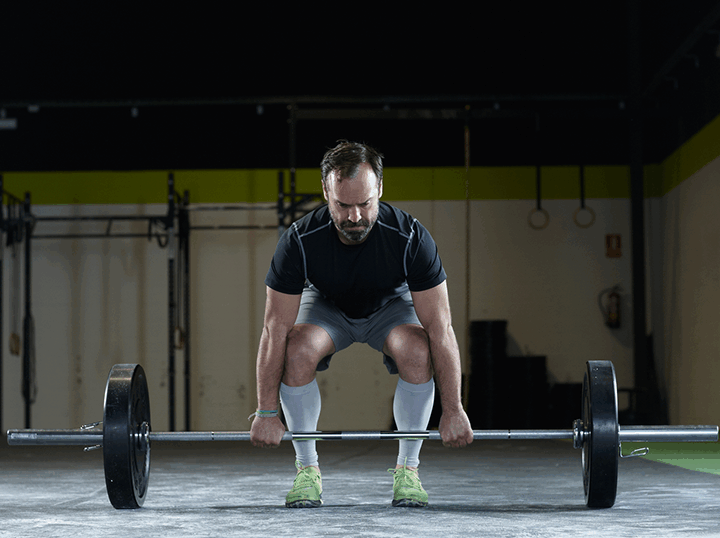Free Weights vs. Machines: What Actually Builds Strength for a Longer Life?

If you want to live longer and move better for decades to come, [strength tray-ning]nounResistance-based exercise to build muscle and support healthy aging.Learn More is an absolute must.
Building and maintaining [muh-suhl mas]nounThe total weight of muscle in your body, critical for longevity.Learn More helps you do the things you want to do in every phase of life—and it may protect you from metabolic disease, according to a study published in Endocrinology and Metabolism.
There are two main options for strength training: machines and free weights. Which is better? Which will help you most effectively build [ri-zil-yuhns]nounThe ability to recover quickly from stress or setbacks.Learn More, bone strength, and full-body functional fitness?
Before we get into the details, let’s get one thing out of the way: both weight machines and free weights are great. As long as you’re lifting heavy enough, they’ll both help you build muscle and future-proof your body.
Let’s take a look at what might make you choose one or the other. Then we’ll outline a plan that walks you through the best type of [helth-span]nounThe number of years you live in good health, free from chronic illness or disability.Learn More-boosting resistance training for your experience level.
Weight Machines: A Safe Start for Building Muscle at Any Age
You’re probably quite familiar with weight machines. They use cables, levers, and pulleys to let you move a stack of weights—these are things like leg extensions, leg curls, lat pull-downs, and chest presses.
Weight machines have some big advantages.
Most importantly, they’re very approachable. It’s a lot less intimidating to sit on a leg extension machine than it is to step up to a squat rack for the first time. And that’s no small thing, especially when you’re just getting started.
There’s a persistent myth that weight machines won’t make you as strong as free weights. But that’s just not true, according to a study published in Medicine & Science in Sports & Exercise. And there’s the bonus that machines may be less likely to cause injury, according to another study. Both of these are great news for fans of weight machines who want to build lasting strength.
Weight machines have some disadvantages, though, too.
The main criticism is they don’t reflect the demands of real life. What do you want from strength training? Do you want to be able to hike or play tennis? You’ll need to use dozens of muscles in concert. Weight machines usually focus on one muscle group at a time, which just isn’t how we move in the world.
Free Weights: Boost Bone Density, Balance, and Brain-Body Power
Free-weight exercises use barbells or dumbbells to provide resistance instead of the weight stacks on machines. These are exercises like squats, deadlifts, lunges, overhead presses, and so on.
There are some very significant upsides to using this type of resistance training.
Free weights are highly applicable to real life. Exercises like squats and bench presses force you to use stabilizer muscles that help you balance, control heavy objects, and protect your joints. And if you’re using strength training to improve your quality of life and boost [lon-jev-i-tee]nounLiving a long life; influenced by genetics, environment, and lifestyle.Learn More, those stabilizers are very important, because you use them every day.
Research also suggests that heavy free-weight exercises may be the best for increasing [bohn min-er-uhl den-si-tee]nounA key indicator of bone strength and fracture risk.Learn More, something you want to pay attention to if you’re planning a long, healthy life.
But, again, there are tradeoffs.
Free weight exercises require some skill and practice. If you’ve never deadlifted before, stepping up to a loaded barbell isn’t a great idea unless you have a trainer or coach nearby to teach you how to do it (which is a worthy investment in your long-term health).
And, because you need to stabilize heavy loads, you won’t be able to move as much weight—though research shows that you generally get more total muscle activation with free weights than you do with machines.
Machines vs. Free weights: Which is better for you?
So, both machines and free weights have advantages and disadvantages. Which should you choose if you’re looking to build [fuhngk-shuh-nl strength]nounStrength that translates to everyday tasks and movements.Learn More that supports longevity and resilience?
In the end, it’s about what you enjoy and what you’ll stick with. Research shows that both methods of resistance training result in increases in strength, muscle size, and some functional measurements.
Here’s what that means for you: if you like weight machines, use them. If you prefer free weights, great. Do what you enjoy.
But if you want to maximize the benefits you get from strength training, consider building a plan that progresses from weight machines to free-weight exercises.
A Smart Strength Training Progression Plan
If you’re looking to maximize the functional benefits of strength training, free weights do have a slight advantage. Unstable loads and moving weights while you’re standing reflect the demands of real life, which is usually what we’re training for.
If you’re not ready to try your hand at heavy barbell lifting, you can follow a plan to get there that helps you build strength, muscle size, and functional ability in the meantime.
Here’s how to do it:
- Start on Your Machine of Choice. They’re safe, easy to use (if you read the instructions), and let you adjust the weight without having to carry plates around. Focus on single-joint exercises, like:
- Leg extensions or tricep extensions
- After a month or so, progress to multi-joint exercises like the leg press, chest press, and shoulder press.
- Begin Mixing in Dumbells: When you’re ready to move on (again, probably after a month or so), start mixing in exercises with dumbbells. Try exercises like:
- The bench press, lunges, and squats, using dumbbells instead of a barbell.
- Move on to the Barbell: After another month or so, it’s time to get the most out of your strength training with a barbell. You might feel most comfortable if you work with a trainer for a few sessions or take a couple classes. Just know that everyone feels awkward when they start lifting. And remember that it’s absolutely worth pushing through your discomfort to get the most out of your strength training.
Whether you’re using machines or free weights, there are some basic principles to follow when you’re trying to build long-lasting strength:
- Train 2–3 Times per Week: Try to take at least one day off between strength training sessions. You get stronger when you rest! (It can be an [ak-tiv ri-kuhv-uh-ree]nounGentle movement between workouts to aid in muscle recovery.Learn More day, with walking, hiking, yoga, or something else that doesn’t tax your muscles too much.)
- Focus on Large Muscle Groups: You don’t need to have a complicated plan, like “legs and back on Mondays and Fridays, chest and arms on Wednesdays and Saturdays.” But you should focus on the large muscle groups you use in your daily life—legs, hips, chest, arms, and back. Try to exercise each group at least twice per week.
- Track Your Strength Gains: Don’t worry about losing weight or getting bulky. This is about getting strong and healthy for the years to come. Try to move more weight often—that’s how you know you’re getting stronger.
Remember, the best plan is the one that you’ll stick with. If you want to use machines, use machines. Prefer free weights? Use free weights.
But if you want to get the most benefit out of your time in the gym, free weights will give you the real-world strength and moh-bil-i-tee]nounThe ability to move freely and easily through a full range of motion.Learn More that helps you stay active, independent, and vibrant in your 60s, 70s, 80s, and beyond.
The information provided in this article is for educational and informational purposes only and is not intended as health, medical, or financial advice. Do not use this information to diagnose or treat any health condition. Always consult a qualified healthcare provider regarding any questions you may have about a medical condition or health objectives. Read our disclaimers.

